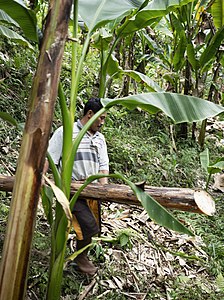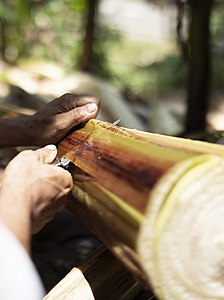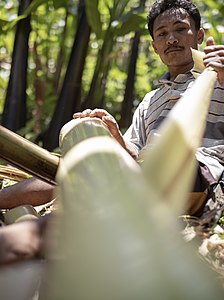User:John Cummings/Archive/Bananatex
 | |
| Type | Fabric |
|---|---|
| Manufacturer | QWSTION |
| Available | Yes |
| Current supplier | QWSTION |
| Website | https://www.bananatex.info/ |
Bananatex is a natural biodegradable fabric made using Abacá banana plant fibres, also known as Manila hemp.[1][2] The plants are grown in the Philippines as part of a sustainable forestry initiative in Catanduanes. Bananatex is used in both Qwestion products and by other companies.[3][4][5][6] It is manufactured uncoated or with a natural beeswax waterproof coating and in different colours.[7][8] Banantex is distributed through QWSTION International GmbH.[9]
Development
[edit]Bananatex was developed over three years by Swiss fashion brand Qwstion, which was founded in 2008 to research renewable materials to replace synthetic textiles.[10][11][12] It was created in collaboration with a Taiwanese yarn specialist weaving company to address environmental, economic and social sustainability issues of petroleum based synthetic materials in the textile manufacturing industry.[1][13][14]
Production Process
[edit]Unlike cotton and some other natural fibres Abacá plants require no pesticides, herbicides or irrigation.[15] This allows reforestation in areas which were monoculture oil palm plantations and in deforested rainforest cut down for lumber. Growing the Abacá plants reduces erosion, increases biodiversity and enriches the soil.
Cultivation:
[edit]The Abacá plants are grown in Catanduanes in the Philippine highlands without the use of water or pesticides. The banana plant is harvested three times per year.
-
1. Abacá plants have several stalks which can be harvested annually and regenerate fully within a year.[16]
-
2. Abacá plants are harvested by “topping”, cutting the leaves with a bamboo sickle, cutting or “tumbling” the stalks. The leaves are compost on the ground, creating a fertiliser.
-
3. The tuxy, the outer layer of the leaf sheath contains primary fibres is separated from the inner layers.
-
4. The inner layers contain the secondary fibres and pulpy material.
-
5.The tuxies are separated by hand using a stripping knife at the harvesting site.
-
6. The fibres are then “combed” to separate them.
-
7. The fibres are then air-dried and bundled together before being transported from forest to the trading warehouse of the farmers cooperative.
-
8. There they are sorted by colour grades, with lighter coloured fibres being more expensive due to their rarity.[17]
Processing
[edit]-
1. The raw fibres are tied with rope and shipped to Mindanao, Philippines, where they are boiled and pressed into cardboard like sheets which are then shipped to Taiwan.[18]
-
2. The abacá fibre sheets are then soaked in water.
-
3. They are then made into paper which are then cut into strips.
-
4. The paper strips are then spun into yarn.
Dying and weaving
[edit]-
1. The natural white yarn is sent to Qwstion’s dyeing and weaving partner in Tainan, Taiwan. They colour the yarn using the yarn dyeing method which is more sustainable than the roll dyeing alternative and certified OekoTex® Standard 100, the highest standard.[19]
-
2. The warp yarns are then prepared for weaving.
-
3. The yarn is then woven at extra high density.
-
Weaving looms processing the Bananatex fabric.
-
4. A natural beeswax coating is added to make the fabric waterproof.
Material Properties
[edit]The fibre of Abacá hemp has many different industrial applications due to its extremely high mechanical strength and length of 2 to 3 metres.[1] These mechanical properties make Bananatex strong and durable, while also being soft, lightweight and flexible.[20][21]
Awards and prizes
[edit]- 2020: German Sustainability Award Design 2021 Winner (Category: Pioneers)
- 2019: Bundespreis Ecodesign Winner (Category: Product)
- 2019: Design Preis Schweiz Winner (Category: Textile Design)[22]
- 2019: Green Product Award 2019, Category: Material for Bananatex® by QWSTION
- 2019: Cannes Corporate Media and TV Awards 2019, Gold in category: Marketing Communication B2C for Bananatex®
- 2018: Goldener Hase, Category: Design for Bananatex by QWSTION
External Link
[edit]References
[edit]- ^ a b c Peters, Adele (2019-04-12). "This new technical fabric replaces polyester with banana plants". Fast Company. Retrieved 2021-07-12.
- ^ Brouwer 2020-02-05T15:00:01Z, Lotte (2020-02-05). "Follow your Eco-Conscience – trends in sustainable living". livingetc.com. Retrieved 2021-07-12.
{{cite web}}: CS1 maint: numeric names: authors list (link) - ^ Zeitung, Süddeutsche. "Neue Formen". Süddeutsche.de (in German). Retrieved 2021-07-16.
- ^ Hughes, Huw (2021-03-22). "H&M x Good News launch sneaker collection made with Bananatex". FashionUnited. Retrieved 2021-07-16.
- ^ Hughes, Huw (2021-01-28). "Meet Qwstion, the Swiss brand making premium bags from banana plants". FashionUnited. Retrieved 2021-07-16.
- ^ "H&M To Launch 'Sustainable' Sneakers Made From Banana Fibers". Plant Based News. 2021-04-06. Retrieved 2021-07-16.
- ^ julia.beirer (2020-01-14). "Total Banane: Drei Designer kreieren nachhaltige Sessel". kurier.at (in German). Retrieved 2021-07-16.
- ^ Hughes, Huw (2019-03-18). "Ten innovations for a more circular fashion production process". FashionUnited. Retrieved 2021-07-16.
- ^ "8 Sustainable Yarns and Fibers". Metropolis. 2020-10-22. Retrieved 2021-07-12.
- ^ "QWSTION Creates a Minimalist Bag Collection Made From Banana Plants". Design Milk. 2020-01-06. Retrieved 2021-07-12.
- ^ "Start-up Qwstion: Gründer Hannes Schönegger stellt Taschen aus Bananen her". www.handelsblatt.com (in German). Retrieved 2021-07-16.
- ^ "Bananatex launches a sustainable material revolution at Milan Design Week". Retrieved 2021-07-16.
- ^ "Eliminating silo thinking and the word 'waste', plus a tip from Jimi Hendrix". www.innovationintextiles.com. Retrieved 2021-07-16.
- ^ Preuss, Simone (2018-10-15). "Qwstion stellt nachhaltige Taschen aus Bananatex vor". FashionUnited (in German). Retrieved 2021-07-16.
- ^ Rabl, 02 05 2019 um 09:54 von Sissy (2019-05-02). "Bananatex und Ochsenblut: Die Innovationen der Textilindustrie". Die Presse (in German). Retrieved 2021-07-16.
{{cite web}}: CS1 maint: numeric names: authors list (link) - ^ "BANANATEX®". www.bananatex.info. Retrieved 2021-07-12.
- ^ "Bananatex®, the World's First Waterproof Fabric Made From Banana Plants". Global Shakers. 2020-04-27. Retrieved 2021-07-12.
- ^ "BANANATEX®". www.bananatex.info. Retrieved 2021-07-12.
- ^ "Eliminating silo thinking and the word 'waste', plus a tip from Jimi Hendrix". www.innovationintextiles.com. Retrieved 2021-07-12.
- ^ "QWSTION Creates a Minimalist Bag Collection Made From Banana Plants". Design Milk. 2020-01-06. Retrieved 2021-07-16.
- ^ Corti, David Streiff; Corti, David Streiff. "Qwstion: Das Label aus Zürich setzt auf Nachhaltigkeit". NZZ Bellevue (in German). Retrieved 2021-07-16.
- ^ "QWSTION's waterproof fabric made from banana plants wins design prize switzerland 2019". designboom | architecture & design magazine. 2019-11-03. Retrieved 2021-07-12.

![1. Abacá plants have several stalks which can be harvested annually and regenerate fully within a year.[16]](http://upload.wikimedia.org/wikipedia/commons/thumb/8/89/01-QWSTION-BANANATEX-ABACA-LEAVES-LAUSCHSICHT.jpg/224px-01-QWSTION-BANANATEX-ABACA-LEAVES-LAUSCHSICHT.jpg)






![8. There they are sorted by colour grades, with lighter coloured fibres being more expensive due to their rarity.[17]](http://upload.wikimedia.org/wikipedia/commons/thumb/e/ec/23-QWSTION-BANANATEX-ABACA-GRADES.jpg/224px-23-QWSTION-BANANATEX-ABACA-GRADES.jpg)
![1. The raw fibres are tied with rope and shipped to Mindanao, Philippines, where they are boiled and pressed into cardboard like sheets which are then shipped to Taiwan.[18]](http://upload.wikimedia.org/wikipedia/commons/thumb/d/dc/30-QWSTION-BANANATEX-FIBER-PULP-SHEETS-LAUSCHSICHT.jpg/224px-30-QWSTION-BANANATEX-FIBER-PULP-SHEETS-LAUSCHSICHT.jpg)



![1. The natural white yarn is sent to Qwstion’s dyeing and weaving partner in Tainan, Taiwan. They colour the yarn using the yarn dyeing method which is more sustainable than the roll dyeing alternative and certified OekoTex® Standard 100, the highest standard.[19]](http://upload.wikimedia.org/wikipedia/commons/thumb/2/2c/36-1-QWSTION-BANANATEX-YARN-DYEING-2.jpg/224px-36-1-QWSTION-BANANATEX-YARN-DYEING-2.jpg)



